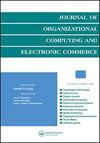联机交易中安全认证的附加因素的实现
IF 1.9
4区 管理学
Q3 COMPUTER SCIENCE, INFORMATION SYSTEMS
Journal of Organizational Computing and Electronic Commerce
Pub Date : 2019-07-29
DOI:10.1080/10919392.2019.1633123
引用次数: 10
摘要
摘要为了根除金融欺诈,政府鼓励金融交易数字化,数字经济范式也加强了这一点。最近,电子交易数量呈指数级增长,与网络交易欺诈有关的网络犯罪发生率也在增加。为了防止网上交易欺诈,金融交易相关公司的利益相关者在各级实施了各种安全认证和授权做法。在本文中,提出了在线交易安全认证的一个附加因素。除了个人识别号(PIN)和一次性密码(OTP)之外,还提出了第三种身份验证因素,该因素基于发起交易的用户的全球定位系统(GPS)位置。该策略是基于交易设备和用户的移动设备之间的指定距离约束来批准/拒绝交易;该距离被用作验证在线交易的附加认证因素(第三因素)。本研究的主要目的是防止欺诈者使用不属于用户且当前不在用户手中的设备进行在线交易。仿真结果表明,该方法具有较高的检测率,即98.55%。本文章由计算机程序翻译,如有差异,请以英文原文为准。
Implementation of an Additional Factor for Secure Authentication in Online Transactions
ABSTRACT To eradicate financial fraud, governments encourage the digitization of financial transactions, which is also reinforced by the digital economy paradigm. Recently, there has been an exponential increase in the number of e-transactions, and the incidence of cyber crimes related to online transaction fraud has also been increasing. To prevent online transaction fraud, the stakeholders of financial-transaction-related companies have implemented various secured authentication and authorization practices at all levels. In this paper, an additional factor for secure authentication for online transactions has been proposed. A third authentication factor, in addition to Personal Identification Number (PIN) and one time password (OTP), has been proposed, which is based on the global positioning system (GPS) location of the user who initiates the transaction. The strategy is to approve / decline the transaction based on a specified distance constraint between the transaction device and the user’s mobile device; this distance is used as an additional authentication factor (third factor) to verify the online transaction. The main objective of this study is to prevent fraudsters from performing online transactions from devices that do not belong to the user and are not currently in the possession of the user. The simulation results show that a high detection rate, i.e., 98.55%, is obtained using the proposed method.
求助全文
通过发布文献求助,成功后即可免费获取论文全文。
去求助
来源期刊

Journal of Organizational Computing and Electronic Commerce
工程技术-计算机:跨学科应用
CiteScore
5.80
自引率
17.20%
发文量
7
审稿时长
>12 weeks
期刊介绍:
The aim of the Journal of Organizational Computing and Electronic Commerce (JOCEC) is to publish quality, fresh, and innovative work that will make a difference for future research and practice rather than focusing on well-established research areas.
JOCEC publishes original research that explores the relationships between computer/communication technology and the design, operations, and performance of organizations. This includes implications of the technologies for organizational structure and dynamics, technological advances to keep pace with changes of organizations and their environments, emerging technological possibilities for improving organizational performance, and the many facets of electronic business.
Theoretical, experimental, survey, and design science research are all welcome and might look at:
• E-commerce
• Collaborative commerce
• Interorganizational systems
• Enterprise systems
• Supply chain technologies
• Computer-supported cooperative work
• Computer-aided coordination
• Economics of organizational computing
• Technologies for organizational learning
• Behavioral aspects of organizational computing.
 求助内容:
求助内容: 应助结果提醒方式:
应助结果提醒方式:


